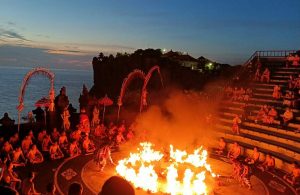Tucked in the lush heart of Ubud, Bali, the Sacred Monkey Forest Sanctuary is more than just a place to see monkeys—it is a vibrant confluence of spirituality, ancient architecture, wildlife, and jungle serenity. For travelers seeking a unique blend of culture and nature, this sanctuary offers an experience unlike nearly any other.
What is the Monkey Forest Sanctuary?
Officially known as the Padangtegal Monkey Forest, this sanctuary is a protected area of rainforest covering approximately 12 hectares, located just a few kilometers from central Ubud. It is home to hundreds of long-tailed macaques (Macaca fascicularis), ancient Balinese temples, forested pathways, moss-covered statues, and dense flora.
The forest isn’t only a wildlife preserve; it houses three Hindu temples: Pura Dalem Agung Padangtegal, Pura Beji, and another smaller shrine. These temples date back centuries and are still used for religious ceremonies, making the spot spiritually significant.
What Makes It Unique
-
Monkeys and humans, up close: The macaques roam freely within the forest. Visitors get to walk among them, observe their behavior, and sometimes have playful interactions. It’s not completely predictable—sometimes the monkeys are calm, other times mischievous.
-
Ancient temple ruins in the woods: The temple architecture and stone carvings, partially reclaimed by nature, lend a mystical atmosphere. Statues, moss, falling vines, and giant trees create an immersive, almost magical ambiance.
-
A jungle escape close to civilization: Although it feels remote, Ubud Monkey Forest is only minutes from Ubud’s cafes, art galleries, and hotels. This makes it ideal for half-day visits or combining it with cultural, dining, or shopping excursions.
-
Photogenic settings: The interplay of light and shade through jungle canopy, reflections on wet moss, monkeys climbing ancient stones—these provide many opportunities for memorable photographs.
What to Do & When
-
Time your visit: Early morning is best—cooler temperatures, fewer crowds, better light, and more active monkeys. Avoid midday when heat and crowds are greater.
-
Respectful behavior: Don’t tease or provoke the monkeys. Avoid feeding unless explicitly allowed and under guidance. Hold on to loose belongings; monkeys are curious and sometimes grab sunglasses, water bottles, or hats.
-
Explore the temples: Walk the forest paths to visit each temple. Observe the carvings, shrines, and shrines’ altars. Respect temple rules—often sarongs and sashes are needed, modest dress required.
-
Combine with other Ubud experiences: After the forest, visitors can go to nearby rice terraces, local art markets, or cafés. Ubud has many wellness offerings—yoga, spas—that complement a nature-filled morning.
Practical Info
-
Entrance fee: There is a charge for visitors; it helps with conservation and maintenance. (Fees change, so check current rates before visiting.)
-
Location & access: Located in Padangtegal, about 2–3 km from Ubud’s center. Taxis, motorbike, or walking (if staying nearby) are common.
-
What to bring: Comfortable walking shoes, water, insect repellent, camera, modest clothing if planning to enter temples.
Why This Sanctuary Matters
Beyond its photogenic value and cute primate residents, the Monkey Forest Sanctuary is an example of how Balinese culture, religion, and nature are deeply interwoven. The temples are not just relics; they are living sites of worship. The forest is not purely for tourism; it is a vital ecosystem. Preserving such places contributes to ecological health, cultural continuity, and spiritual heritage.
In short, when in Bali, a visit to the Sacred Monkey Forest in Ubud is almost essential—for its beauty, its calm, its living culture, and for the sense of being somewhere that merges the wild and the sacred.








